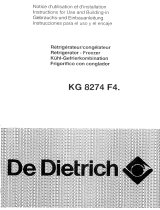
Instructions for Use
12
• Before loading the appliance with fresh food, make sure it
was cooled to ambient temperature.
• Ice and frost layer increase energy consumption, so do
clean the appliance as soon as the layer is 3-5 mm thick.
• If the gasket is damaged or if it turns out that the sealing is
poor, the energy consumption is substantially higher. To
restore efficiency, replace the gasket.
• Condenser at the bottom of the appliance must always be clean
and dust free (see Section Cleaning of the Appliance).
• Always consider instructions stated in sections Positioning
and Energy Saving Tips, otherwise the energy consumption
is substantially higher.
Important
• This appliance is not intended for use by persons (including
children) with reduced physical, sensory or mental
capabilities, or lack of experience and knowledge, unless
they have been given supervision or instruction concerning
use of the appliance by a person responsible for their safety.
• If you have bought this appliance to replace an old one
equipped with a lock that cannot be opened from inside
(lock, bolt), make sure that the lock is broken. This will make
it impossible for children to lock themselves inside
the appliance and suffocate.
• The appliance must be correctly connected to the mains
supply. (see: Connecting to the Mains Supply).
• Do not touch the cooled surfaces while the appliance
operates, especially not with wet hands, because the skin
may stick to the cold surfaces.
• Do not freeze bottles containing liquid, especially not soft
drinks, such as mineral water, sparkling wine, beer, cola
etc., because liquid expands during freezing and the glass
bottle is very likely to blow up.
• Do not eat frozen food (bread, fruit, vegetables), because
you can get frostbites.
• If the food has strange smell or color, throw it away, because it is
very likely that it is spoiled and therefore dangerous to eat.
• Disconnect the appliance from the power supply before
repairing it (only a qualified technician should repair it),
before cleaning and before replacing the light bulb.
• Do not defrost the appliance with other electric appliances
(as for example with hair dryer) and never scrape the frost
layer with sharp objects. Use only enclosed tools or tools
recommended by the manufacturer.
• For the sake of environment protection - be careful not to
damage the rear wall of the appliance (the condenser unit or
the tubes - for example when moving the appliance) or any
part of the refrigerating system inside the appliance.
• The refrigerating system of the appliance is filled with
refrigerant and oil, so when the appliance is damaged,
handle it with care and dispose it of in compliance with
environmental protecting precautions. (See We Care for the
Environment).
• If the supply cord is damaged, it must be replaced by the
manufacturer or his service agent or a qualified person in
order to avoid hazard.
• The rating plate is inside the appliance or outside on the rear
wall.
• Warning: Ventilation slots on the appliance or built-in
element should always be kept clean and unobstructed.
• Warning: Do not use any mechanical accessories when
thawing the refrigerator, except for those explicitly
recommended by the manufacturer.
• Warning: To prevent any pollution be careful not to damage
the insulation or refrigeration tubes at the rear wall during the
installation, cleaning and disposal of the appliance.
• Warning: Do not use any electrical devices inside the
appliance, except for those explicitly recommended by the
manufacturer.
Disposing of the Worn Out Appliance
• When your appliance finally wears out, dispose it of. If the
appliance has a lock, break it, in order to prevent eventual
accidents (danger of children get locked inside the appliance).
• The refrigerating system of the appliance is filled with
refrigerant and insulating substances which should be
separately treated and processed. Call your nearest
authorised service agent or specialised servicing centre. If
you don't find one, contact your local authorities or your
distributor. Be careful not to damage the tubes on the rear
wall of the appliance (danger of pollution).
• To avoid pollution of the environment make sure not to
damage the hose at the bottom of the appliance.
Environmental protection
This appliance’s packaging material is recyclable. Help recycle
it and protect the environment by dropping it off in the
municipal receptacles provided for this purpose.
Your appliance also contains a great amount of
recyclable material. It is marked with this label to
indicate that in countries that are a members of the
European Union the used appliances should not be
mixed with other waste. This way, the appliance recycling
organised by your manufacturer will be done under the best
possible conditions, in compliance with European Directive
2002/96/EC on Waste Electrical and Electronic Equipment.
Contact your town hall or your retailer for the used appliance
collection points closest to your home.
We thank you doing your part to protect the environment.
Placing and Installation
Choosing the Right Place
Place the appliance in a dry and regularly ventilated room.
Allowed ambient temperature depends on the model (class) of
the appliance and is stated on the rating plate of the appliance.
Never place the appliance near heat emitting devices (e.g.
cooker, radiator, water heater or similar devices) and do not
expose it to direct sunlight.
The appliance should be positioned at least 3 cm away from
the electric or gas cooker and at least 30 cm away from the oil
or coal stove. If this is not possible, use an appropriate
insulation.
Class Ambient temparature
SN (sub-normal) from + 10°C to + 32°C
N (normal) from + 16°C to + 32°C
ST (sub-tropical) from + 16°C to + 38°C
T (tropical) from + 16°C to + 43°C













